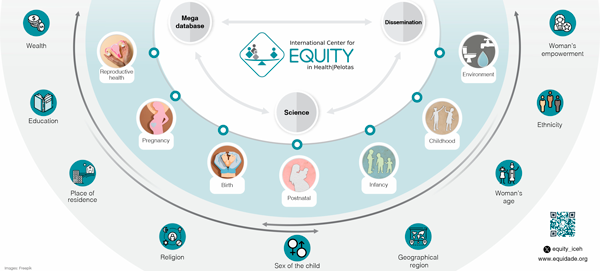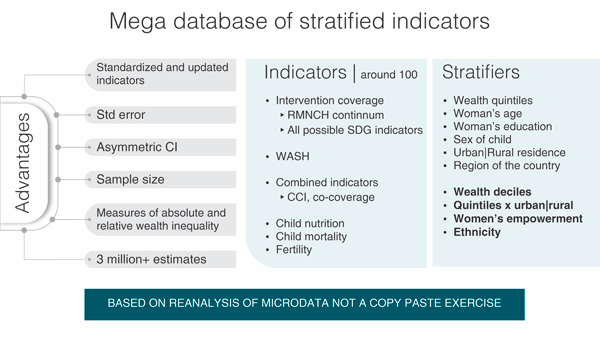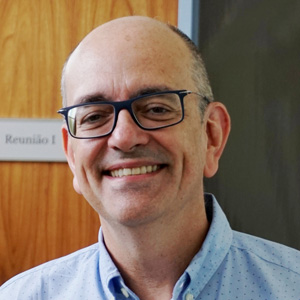Monitoring health equity worldwide: evidence-based information at the tips of your fingers
Author: Aluisio Barros
Everyone deserves decent living conditions that ensure their health, well-being, and security (covering the basics like food, clothing, housing, healthcare and social services). These rights are for every individual, regardless of race, religion, gender, sexual orientation etc. The link between fundamental human rights and fairness is vital. Equity is about providing equal opportunities for everyone, ensuring their rights as humans are respected and enabling their full potential to be unlocked.
The Millennium Development Goals (MDGs), introduced in 2000, and the Sustainable Development Goals (SDGs), launched in 2015, set out to advocate for the well-being and good health for people of all ages while tackling inequalities within and between countries. To truly understand and fight these inequalities, we need to closely monitor the progress of countries in terms of health, with a focus on those people in the most vulnerable situations. Reliable disaggregated data by income, gender, age, race, ethnicity, migratory status, disability, geographic location, and other relevant equity dimensions gives health officials and policymakers the information necessary to shape and execute their strategies more effectively. This is especially important in low- and middle-income countries (LMICs), where detailed health data is scarce and could better inform decision-making in public health.
No data, no evidence, no progress
The challenge of limited health data, especially in LMICs, calls for initiatives that equip policymakers and stakeholders with evidence-based decision-making tools. National surveys like Demographic Health Surveys (DHS) and Multiple Indicator Cluster Surveys (MICS) play a crucial role in monitoring various health indicators, offering a broad view of a country’s health landscape. In 2009, the International Center for Equity in Health (ICEH) was created at the Federal University of Pelotas with a clear mission: to monitor progress in reproductive, maternal, newborn, child and adolescent health through indicators proven to be essential for improving health and well-being and reducing maternal and child mortality. The ICEH’s inception was closely tied to the Countdown to 2015 initiative, a global effort to track countries’ progress toward achieving the MDGs in which the centre’s founders were already engaged.
The ICEH operates on three core pillars: maintaining a comprehensive health equity database, disseminating information and building capacity, and making a scientific impact. What sets ICEH apart is its focus on equity. The team regularly breaks down data across various inequality dimensions, including income, region, area of residence, education level and gender. This is done continuously, incorporating new survey data as they become available. For example, when examining the proportion of children who receive polio immunisation, ICEH not only provides a national estimate, it offers estimates according to different subgroups, including the poorest and wealthiest families, mothers with varying levels of education, residents of rural and urban areas, boys and girls, and more. Additionally, ethnicity, religion, women’s empowerment and other dimensions are also investigated in specific projects.

Tools and actions for health equity monitoring
Global health equity database
Freely available data is a fundamental driver for progress in healthcare. Nonetheless, it is important to go beyond national survey data to unlock its true potential. The selection of appropriate indicators and their disaggregation reveals disparities that might otherwise remain hidden. This process paves the way for transparent policymaking and a more informed, equitable and efficient healthcare system.
Recognising the importance of open data access, the ICEH maintains a comprehensive database of health indicators that are estimated in a standardised way, and stratified by all possible equity dimensions. The estimates come from the re-analysis of DHS and MICS data. It comprises data collected from over 460 surveys conducted across 122 countries. This database is publicly available on the Health Inequality Data Repository through the Health Equity Assessment Toolkit (HEAT). The repository was recently released by the World Health Organization (WHO) and is the largest global collection of inequality data, containing around 11 million points of disaggregated data. The ICEH has maintained a long-term partnership with the WHO, which led to the recognition of the ICEH as a WHO Collaborating Centre.

Dissemination of information
Equity profiles
Summarising disaggregated estimates is a way to offer a glimpse into the status and trends of health inequalities within a given country, particularly in the context of essential health interventions throughout all stages of what is known as the continuum of care – key stages in the lives of women and children that begin before pregnancy and go all the way through childhood. The ICEH, in partnership with Countdown to 2030, offers four-page brochures for countries to self-assess their health equity through equity profiles. This sheds light on disparities in intervention coverage across various social dimensions, including income, gender, place of residence and ethnicity.
Equiplots
An equiplot is a visualisation tool that presents equity data in an intuitive and easily understandable manner for healthcare professionals, policymakers and the general public. In this graph, each dot represents a specific subgroup, and the distance between the dots reflects the magnitude of the inequalities. This visual approach, proposed by ICEH, is highly effective for highlighting disparities across different indicators, countries or time periods. Stata codes for generating equiplots are freely available on ICEH’s website. Additionally, ICEH provides the Equiplot Creator Tool, an online resource that is also freely accessible. This online tool simplifies the process of creating an equiplot, even for individuals without advanced programming or statistical knowledge.
Equity dashboard
Recognising that national averages can hide persistent inequalities in population subgroups, and the importance of equity for overall country progress, ICEH has proposed an equity dashboard. The interactive dashboard visualises data related to reproductive, maternal, newborn and child health indicators, categorised by wealth, place of residence, women’s education and subnational regions. It enables comparisons between and within countries so that selected peer countries can serve as a benchmark for progress evaluation.
Health inequality measures to go
Comparing inequalities between subgroups, countries, indicators and time points is at the heart of monitoring health inequalities. The ICEH has developed stata codes for two complex measures of inequality: the slope index of inequality (SII) for absolute inequality; and the concentration index (CIX) for relative inequality. Typically, health coverage leans toward the wealthier groups, yielding a positive measure and characterising a pro-rich pattern. Both measures are frequently taught in courses and capacity-strengthening initiatives conducted by the group, along with other inequality measures and dimensions. These codes can be downloaded from the website, and aim to empower users to assess various ordinal equity dimensions effectively.
Scientific impact
Ever wondered why research matters so much in the world of healthcare? High-quality research in public health turns data into actionable insights, empowering healthcare professionals with up-to-date information to make informed decisions. Publications in high-impact journals boost the visibility of health issues, making a difference in healthcare efficiency and people’s lives. The ICEH is an example of a research centre dedicated to building professional capacity and advancing scientific progress. From its inception, the group has nurtured over 30 master’s and PhD students, as well as post-doctoral fellows, shaping their academic journeys.
The group’s scientific contributions primarily come from peer-reviewed journal articles and input provided for reports from international organisations, such as UNICEF, WHO and PAHO, fostering global collaboration and the sharing of best practices adaptable to local contexts. This international perspective ensures that healthcare innovations transcend regional boundaries, benefiting people worldwide. With nearly 15 years of existence, the group has authored over 160 scientific publications. While their core focus remains on addressing disparities in reproductive, maternal, newborn and child health, the ICEH has expanded its research to encompass topics like intimate partner violence, water, sanitation and hygiene, and gender-related indicators. For a deeper dive into the ICEH’s activities and initiatives, visit the website.
Conclusion
A commitment to nurturing equitable and evidence-driven decision-making enables the global community to work together towards achieving better health outcomes for all. The goal is clear: to ensure that health policies, programs and practices prioritise the needs of the most vulnerable and disadvantaged populations. While substantial progress has been made in equity analysis, including the development of new tools and indicators, increased investment in both research and practical initiatives remains imperative to advance a fairer society.
Take-home messages
- Data are essential for evidence-based monitoring of progress towards the SDGs, and national health surveys such as DHS and MICS are the main sources for LMICs.
- Standardised indicators are crucial to assessing progress over time and comparing a country’s situation to their peers. Such indicators are available from the WHO Equity Data Repository.
- Analysis and visualisation tools, such as those provided by the ICEH on its website, are vital for presenting evidence in a way that a non-academic audience can understand, interpret and take action on.
Authors
Aluisio J D Barros, Caroline S Costa, Francine S Costa, Leonardo Z Ferreira, Lissandra A Santos and Natália P Lima
1. Federal University of Pelotas, Pelotas, Brazil; International Center for Equity in Health, Pelotas, Brazil
Disclaimer
The views expressed in this World EBHC Day Blog, as well as any errors or omissions, are the sole responsibility of the author and do not represent the views of the World EBHC Day Steering Committee, Official Partners or Sponsors; nor does it imply endorsement by the aforementioned parties.
